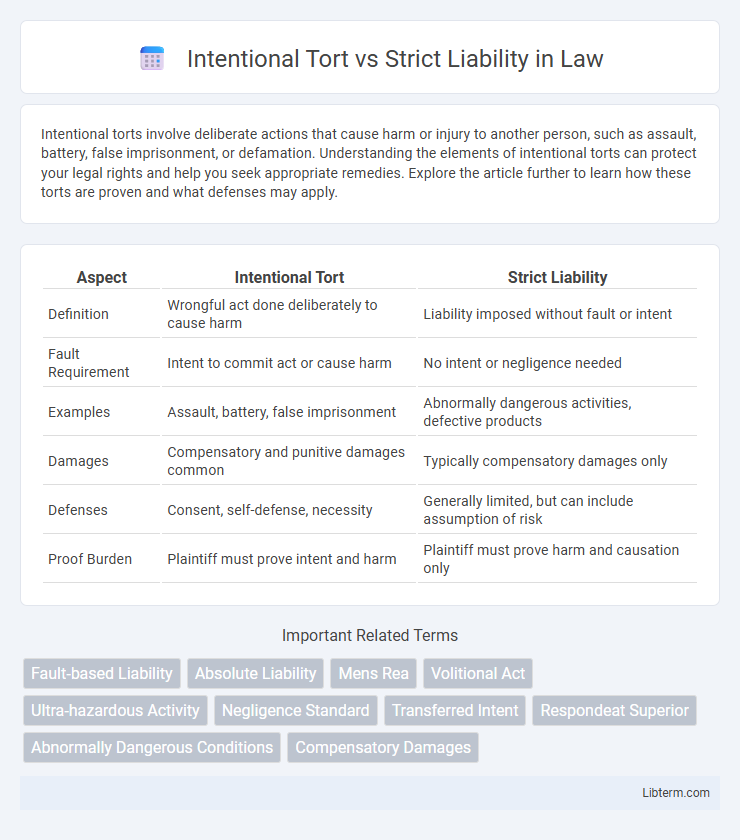Intentional torts involve deliberate actions that cause harm or injury to another person, such as assault, battery, false imprisonment, or defamation. Understanding the elements of intentional torts can protect your legal rights and help you seek appropriate remedies. Explore the article further to learn how these torts are proven and what defenses may apply.
Table of Comparison
| Aspect | Intentional Tort | Strict Liability |
|---|---|---|
| Definition | Wrongful act done deliberately to cause harm | Liability imposed without fault or intent |
| Fault Requirement | Intent to commit act or cause harm | No intent or negligence needed |
| Examples | Assault, battery, false imprisonment | Abnormally dangerous activities, defective products |
| Damages | Compensatory and punitive damages common | Typically compensatory damages only |
| Defenses | Consent, self-defense, necessity | Generally limited, but can include assumption of risk |
| Proof Burden | Plaintiff must prove intent and harm | Plaintiff must prove harm and causation only |
Understanding Intentional Tort: Key Concepts
Intentional torts involve deliberate actions that cause harm or injury to another person, requiring proof of intent to commit the act. Key concepts include purposeful conduct, knowledge of likely consequences, and direct causation between the defendant's actions and the plaintiff's damages. Unlike strict liability, which imposes responsibility without fault, intentional tort claims hinge on demonstrating the defendant's willful misconduct.
Defining Strict Liability in Law
Strict liability in law imposes responsibility on a party for harm caused regardless of intent or negligence, primarily applied in cases involving abnormally dangerous activities or defective products. Unlike intentional torts, which require proof of deliberate actions to cause harm, strict liability focuses on the nature of the activity or product risk. This legal doctrine ensures victims can recover damages without proving fault, emphasizing public safety and risk management.
Core Differences Between Intentional Tort and Strict Liability
Intentional torts require proving that the defendant acted with intent to cause harm, whereas strict liability holds defendants responsible for damages regardless of intent or negligence. In intentional torts, the plaintiff must establish deliberate actions, such as assault or fraud, while strict liability typically applies to inherently dangerous activities or defective products where fault is irrelevant. The core difference centers on the mental state of the defendant: intentional torts demand intent, strict liability does not.
Elements Required to Prove Intentional Tort
Intentional tort requires proving purposefully wrongful conduct, including act, intent, and causation of harm, where the defendant's deliberate actions lead directly to injury or damage. The plaintiff must establish that the defendant intended to perform the act that caused the harm, not necessarily to cause the harm itself. Unlike strict liability, intent is essential, as strict liability imposes responsibility without proving intent or negligence.
Essential Components of Strict Liability Claims
Strict liability claims require proving that the defendant engaged in an inherently dangerous activity or possessed a dangerous product that caused harm, without needing to establish intent or negligence. Essential components include causation, actual damages, and the dangerous nature of the activity or product involved. The plaintiff must demonstrate that the harm directly resulted from the defendant's conduct, making fault or intent irrelevant in these cases.
Common Examples of Intentional Torts
Common examples of intentional torts include assault, battery, false imprisonment, trespass to land, and defamation. These acts involve deliberate actions intended to cause harm or offense to another person, distinguishing them from strict liability cases where fault or intent is not required. Intentional torts often result in compensatory and punitive damages due to the willful nature of the misconduct.
Notable Cases Involving Strict Liability
In landmark cases such as Rylands v Fletcher (1868), strict liability was established, holding defendants liable for hazardous activities regardless of fault. Another notable case, Greenman v Yuba Power Products, Inc. (1963), expanded strict liability to product defects causing injury. These cases underscore the legal principle that certain activities or products impose automatic liability to protect public safety.
Legal Defenses Against Intentional Tort Allegations
Legal defenses against intentional tort allegations include consent, self-defense, defense of others, and defense of property. Consent serves as a valid defense when the plaintiff agreed to the defendant's conduct, negating liability. Self-defense and defense of others justify the use of reasonable force to prevent harm, while defense of property allows protection against unlawful intrusions without excessive force.
Defenses and Exceptions in Strict Liability
Strict liability imposes responsibility without fault but allows defenses such as assumption of risk, where the plaintiff knowingly engages in a hazardous activity, and comparative negligence, which can reduce damages based on the plaintiff's own fault. Exceptions to strict liability include cases involving naturally occurring hazards or where the defendant's conduct did not create an abnormal risk. Courts often distinguish strict liability from intentional torts by emphasizing the absence of intent and permitting defenses that are unavailable in intentional tort claims.
Choosing the Right Legal Approach: Intentional Tort vs Strict Liability
Choosing the right legal approach between intentional tort and strict liability depends on the nature of the wrongful act and the evidence of intent. Intentional tort claims require proving that the defendant purposely caused harm, making it suitable for cases like assault or fraud. Strict liability applies when harm occurs regardless of fault or intent, commonly used in cases involving inherently dangerous activities or defective products.
Intentional Tort Infographic

 libterm.com
libterm.com